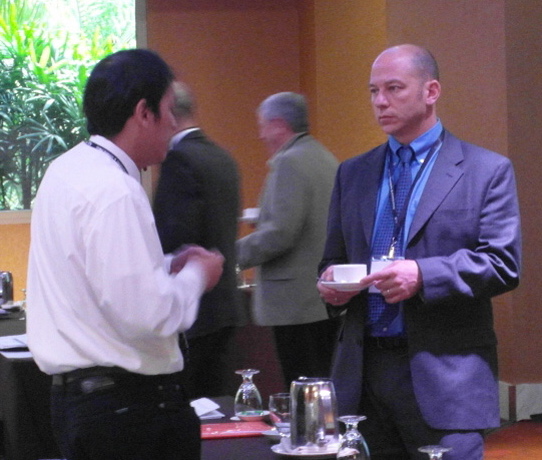As an attendee of the Innovation and Entrepreneurship Conference in dazzling Singapore, I was fortunate to hear many academic papers on the many factors surrounding these two very big words. Papers were presented from all over the world: from Fiji to Iran to the UK. Topics ranged from Structural Equation Modeling (SEM) to reasons for collaboration. One German researcher sat next to me and asked what I was presenting. I said “nothing.” He responded “Oh I see! You are here to criticize! Yes that’s easy.” Point taken. I’ll present next time.
In particular I was drawn to a few presentations, and here are my *personal* take-aways:
1. The keynote presentation given by Dr. Farid Shirazi, PhD of the Ted Rogers School of Information Technology Management at Ryerson University in Toronto. He made a compelling presentation that despite common belief, the Information Technology Economy is creating a bigger environmental strain, not a smaller one.
2. The One Village One Product (OVOP) Approach was studied by Dr. Dana Santoso Saroso from the University of Mercu Buana, Indonesia. His case involved studying how a whole village could sell different value-added products from focusing on growing strawberrie. The increased profitability was impressive. He pointed to the way a village could rally behind the vision given by village mayors to instigate real change in SME development. Absent of the mayor’s dedication, change did not happen.
3. Dr. Nerisa Paladan of Ateneo de Naga University, Philippines presented “Leadership and Entrepreneurial Success of Bicolano Entrepreneurs.” By studying the most successful businesses, she demonstrated that successful leaders who were involved in community organizing and volunteering were able to develop the “transformational leadership style” which became a critical factor for SME success.
4. Prof. Jan van Den Ende of Erasmus University, Netherlands presented “To Ask, to Collaborate or to Propose? Contrasting Views on Customer Involvement in Functional and Experiential Innovation.” His team studied almost 700 design firms and how they interacted with the consumer market. He showed the different paths to commercial success of a new product. He focused on three specific approaches: being passively customer-driven (surveys), actively customer-driven (live interaction) or proactively customer-driven. In the latter he described this process as focusing on th latent needs of the customer, not their stated needs. He drove this home with the widely-attributed quote of Henry Ford: “If I had asked people what they wanted, they would have said a faster horse.” Specifically he attributed this proactive approach as a design-driven approach. From there he studied when each one has its best success rate. Ultimately it appears the customer-driven aproach was well-suited to funcational improvements, an the design-driven approach was better suited to more radical innovation than function.
5. The most charismatic award went to Prof. Alamuri Suryanarayana of Osmania University in India who passionately presented on “The Power of Collaboration in Innovation Management.” He talked about the next wave of globalization 4.0 is to no longer think about outsourcing white collar jobs, but to collaborate with an international talent base. His most salient and compelling argument for collaboration was that it was the fastest path for innovation and that “leaders who do not innovate quickly lose their innovative people.”
Of course my comments should be taken in context of the actual published work. I was able to follow up with a few of these folks already and hope to build on this eye-opening experience of applying measurable rigor to the loosey-goosey terms of innovation and entrepreneurship.
By this photo it looks like I take this topic pretty seriously!


